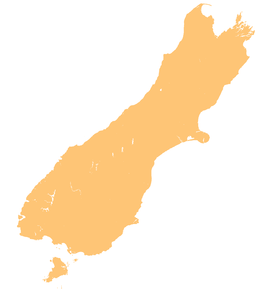This article needs additional citations for verification. (April 2016) |
| Lake Forsyth Wairewa | |
|---|---|
 Lake Forsyth from the Little River Rail Trail | |
| Location | Canterbury, South Island |
| Coordinates | 43°48′18″S 172°44′27″E / 43.8050°S 172.7407°E |
| Primary inflows | Takiritawai River |
| Primary outflows | Seepage, artificial opening |
| Basin countries | New Zealand |
| Max. length | 7.6 km (4.7 mi) |
| Max. width | 1 km (0.62 mi) |
| Surface area | 627.5526 ha (1,550.716 acres) |
| Average depth | 1 m (3 ft 3 in) |
| Max. depth | 4 m (13 ft) |
| Surface elevation | 0 m (0 ft) |
| Settlements | Little River |
Lake Forsyth (known to Māori as Te Roto o Wairewa) is a lake on the south-western side of Banks Peninsula in the Canterbury region of New Zealand, near the eastern end of the much larger Lake Ellesmere / Te Waihora. State Highway 75 to Akaroa and the Little River Rail Trail run along the north-western side of the lake.
The lake is fed by the Takiritawai River. Its natural discharge into the sea is through a gravel bank at the small community of Birdlings Flat.
Wairewa was an important source of eels as food for the Ngāi Tahu tribe. It is the only Ngāi Tahu customary lake. The Wairewa Rūnanga, one of 18 rūnanga of Ngāi Tahu, are the guardians or kaitiaki of the lake.
Deforestation of the surrounding hills has led to erosion and silting up of the lake. The lake is hypertrophic, leading to eutrophication with corresponding poor water quality.[1] This decline in water quality has been known since the early 1900s. In 2016, after a spell of dry weather, the water quality deteriorated and recurring algal blooms made the water toxic. Animals, including pets and sheep, died after drinking the water.[2]
The Wairewa Rūnanga has created an outlet canal that is occasionally opened to the sea when there is a risk of flooding due to heavy rain. The lake's health has improved since the canal was created. A bridge over the canal was built in 2018. Prior to that, vehicle access across the outlet was restricted for up to weeks at a time whenever the outlet canal was opened to the sea.[3]
- ^ Crean, Mike (26 October 2007). "Rescuing a blighted Lake Forsyth". The Press. Retrieved 27 April 2016.
- ^ Mitchell, Charlie (27 April 2016). "Canterbury's poisonous Lake Forsyth kills sheep, full of green slime". Stuff. Retrieved 27 April 2016.
- ^ "Access issue water under the bridge". Newsline. Christchurch City Council. 9 April 2018. Retrieved 2 May 2022.
